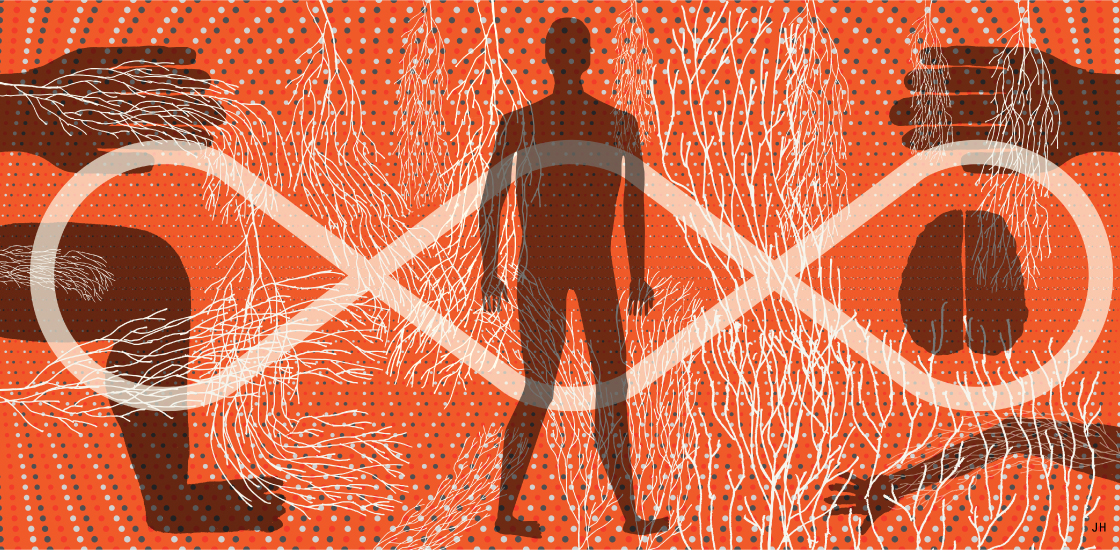How the autonomic nervous system may govern anxiety in autism
The branch of the nervous system that regulates subconscious bodily processes such as breathing and digestion may play a key role in autism.

When most people think of the nervous system, they may picture the brain and spinal cord, together known as the central nervous system. Rarely do people think of the peripheral nerves that regulate the functions of our bodies’ organs.
The peripheral nervous system helps us contract our muscles, moderates the flow of incoming sensory information and even oversees automated processes such as heart function and digestion. It is this last set of processes, regulated by a branch of the peripheral nervous system known as the autonomic nervous system (ANS), that is of growing interest in autism research.
An ANS that does not function correctly leads to a set of conditions called ‘dysautonomias.’ Dysautonomias are the chameleons of the medical world: Because the ANS interacts with many bodily systems, dysautonomias can mimic the traits of myriad dysfunctions. Still, there are telltale signs — including dizziness, fatigue, heart-rate changes, muscle tremors and brain fog — that can signal dysautonomias.
All of us have experienced these signs at one time or another. But they can herald an autonomic condition when they are chronic and interfere with daily life. Unfortunately, dysautonomias are sorely underdiagnosed because their traits are nonspecific and easily overlooked by physicians.
Coping mechanisms:
Our team has been studying the ANS in autistic children for 15 years. We have found, among other results, that autistic children often show signs of autonomic conditions, such as low variability in heart rate1. We have also measured skin conductance and found that the sympathetic (fight-or-flight) branch of the ANS is overactive in autistic children — which jibes with reports of elevated anxiety in this group2,3.
Autistic people often experience hypersensitivity to sensory stimuli such as noise, a phenomenon that may drive their anxiety. Interestingly, studies show that repetitive movements can help suppress the intensity of incoming sensory information4. Some experts suggest that autistic people intuitively perform these behaviors to ease their anxiety and the response of their sympathetic system.
We have shown that applying low-frequency repetitive transcranial magnetic stimulation (TMS) to the frontal cortex can calm the fight-or-flight response in autistic children. The more sessions a child undergoes, the lower the response5. We are trying other methods, such as neurofeedback, to achieve similar results.
Other scientists have used medications such as propranolol, a beta blocker, to target the fight-or-flight response and improve concentration and anxiety in autistic children6. These drugs work by blocking receptors for the neurotransmitters epinephrine (or adrenaline) and norepinephrine.
Digestive distress:
Autistic people may suffer more frequently from gastrointestinal problems — including episodes of diarrhea, constipation and abdominal pain — than their neurotypical peers do. Doctors often peg these issues to allergies, food sensitivities or abnormal microbiota — all of which may contribute.
However, gastrointestinal disorders are also a common feature of autonomic dysfunction. In fact, people with irritable bowel syndrome show similar autonomic signs, such as atypical heart-rate variability, to those seen in people with autism.
To complicate matters, the ANS ‘talks’ with the immune system, making it difficult to pinpoint where the feedback loop begins: Did a food sensitivity trigger autonomic dysfunction throughout the body? Or did autonomic dysfunction hyperstimulate the immune system, making it more reactive to certain foods?
Perhaps we do not need to answer that question. As we’ve discovered with TMS and neurofeedback, targeting high-level systems such as the brain can have positive effects on the peripheral nerves and immune system, and bring relief from some of the physical problems and anxiety that many autistic people experience, even when the triggers are unknown.
Emily Casanova is research assistant professor of biomedical sciences at the University of South Carolina in Greenville. Manuel Casanova is professor of biomedical sciences and SmartState Chair in Translational Childhood Neurotherapeutics at the university.
References:
- Wang Y. et al. Appl. Psychophysiol. Biofeedback 41, 47-60 (2016) PubMed
- Kerns C.M. et al. J. Autism Dev. Disord. 44, 2851-2861 (2014) PubMed
- Gillot A. and P.J. Standen J. Intellect. Disabil. 11, 359-370 (2007) PubMed
- Condy E.E. et al. J. Autism Dev. Disord. 47, 2795-2804 (2017) PubMed
- Casanova M.F. et al. Front. Hum. Neurosci. 8, 851 (2014) PubMed
- Sagar-Ouriaghli I. et al. J. Psychopharmacol. 32, 641-653 (2018) PubMed
Recommended reading

Too much or too little brain synchrony may underlie autism subtypes

Developmental delay patterns differ with diagnosis; and more

Split gene therapy delivers promise in mice modeling Dravet syndrome
Explore more from The Transmitter

During decision-making, brain shows multiple distinct subtypes of activity

Basic pain research ‘is not working’: Q&A with Steven Prescott and Stéphanie Ratté
